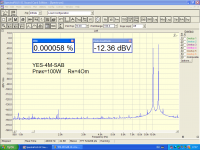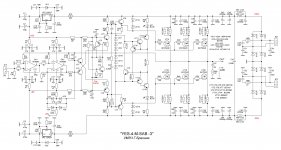Hi all!
In a search for popular amplifier circuits in other countries, I discovered the most popular amplifier circuit among Russians. This amp is called "Only Music 2.7". The scheme was found on the Russian site "cxem.net". The author of the scheme is - "Nem0"

Diy PCB - https://cxem.net/sound/amps/files/amp240_OM27LUT.lay
Gerber PCB - https://cxem.net/sound/amps/files/amp240_OM27_01_(2).zip
The amplifier is actively assembled in russia:
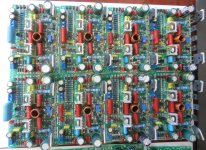
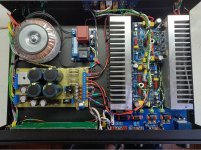
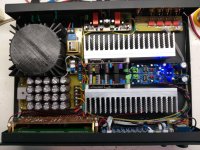
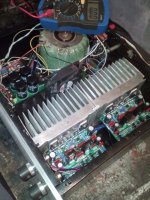
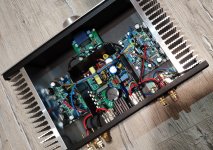
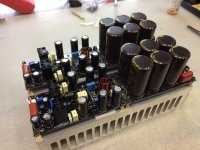
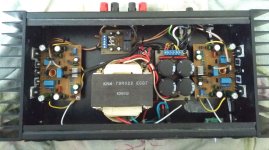
I want to build it. I am interested to know your opinion.
In a search for popular amplifier circuits in other countries, I discovered the most popular amplifier circuit among Russians. This amp is called "Only Music 2.7". The scheme was found on the Russian site "cxem.net". The author of the scheme is - "Nem0"

Diy PCB - https://cxem.net/sound/amps/files/amp240_OM27LUT.lay
Gerber PCB - https://cxem.net/sound/amps/files/amp240_OM27_01_(2).zip
The amplifier is actively assembled in russia:







I want to build it. I am interested to know your opinion.
The circuit design is not too different to many generic designs given an "added touch " .
What I do like is engineering thought has gone into accessibility/layout in case of repair .
What I do like is engineering thought has gone into accessibility/layout in case of repair .
I really like the decent thickness of the the backplates on those heatsinks. It should allow more efficient use of the fins but some of those shown are amazingly thick - perhaps 20mm or more? I guess aluminium must be inexpensive in Russia.
They look like different models.
But it was mentioned on the net that Soviet era stereos and camera lenses produced in the USSR were world class. The cameras were not reliable, but the lenses were improved versions of the original German designs, with better glass and hard coatings, an evolution of the German designs so to speak.
A fascinating topic about audio, if true...I have not come across much information about their sound quality.
Titanium and chromium too are cheap there, apart from aluminum, so their use in weapons and aircraft is more than that in Western equipment.
Heat sink sections are $3 a kilo here, if you use 2 kilos more, you will not go broke.
And your equipment will never break.
As an aside, I met an Indian Army captain long back, he was in charge of an anti aircraft battery...asked him what engines he had on his generators, he said the local ones needed overhaul at 4000 hours, the Soviet ones needed tappet adjustment at that run time, that was all.
They used to keep engines on throughout the six month Siberian winter, or they would freeze. So the engines had to be reliable, never mind the fuel consumption.
A different way of doing things.
That said, the component values look as if they are changed to Western parts numbers.
But it was mentioned on the net that Soviet era stereos and camera lenses produced in the USSR were world class. The cameras were not reliable, but the lenses were improved versions of the original German designs, with better glass and hard coatings, an evolution of the German designs so to speak.
A fascinating topic about audio, if true...I have not come across much information about their sound quality.
Titanium and chromium too are cheap there, apart from aluminum, so their use in weapons and aircraft is more than that in Western equipment.
Heat sink sections are $3 a kilo here, if you use 2 kilos more, you will not go broke.
And your equipment will never break.
As an aside, I met an Indian Army captain long back, he was in charge of an anti aircraft battery...asked him what engines he had on his generators, he said the local ones needed overhaul at 4000 hours, the Soviet ones needed tappet adjustment at that run time, that was all.
They used to keep engines on throughout the six month Siberian winter, or they would freeze. So the engines had to be reliable, never mind the fuel consumption.
A different way of doing things.
That said, the component values look as if they are changed to Western parts numbers.
Last edited:
The best exUSSR schematics of amplifiers for sound your would get here
Its all were superlinear (C).
Most interesting amplifier named ПараФинн in maximum case.
Topic about it is here
It has had realized by lot of hobbists with a stable positive result.
I wish you to a pleasant build.
Schematics and gerber PCB present into topic/
It sounding better than Only Music 2.7
Its all were superlinear (C).
Most interesting amplifier named ПараФинн in maximum case.
Topic about it is here
It has had realized by lot of hobbists with a stable positive result.
I wish you to a pleasant build.
Schematics and gerber PCB present into topic/
It sounding better than Only Music 2.7
Are the schemes listed by you collected in hundreds of copies? I have a desire to collect only music because this is the most popular scheme. It seems that it has become the most popular among Russians for a reason. I have already ordered the boards, I'm waiting for delivery.
I have made OM2.5 MK2
This OM series amps need good cooling as it dissipate a lot of heat.
That’s why you see them using heavy aluminum.
But it sounds very very good with only a passive volume pot at Input.
I think it is better than many diy amps.
This OM series amps need good cooling as it dissipate a lot of heat.
That’s why you see them using heavy aluminum.
But it sounds very very good with only a passive volume pot at Input.
I think it is better than many diy amps.
OM2.5 is the previous model in the line of amplifiers? If you think the previous model is better than many diy amps, then the new only music 2.7 model should be even better. Now I think I understand why this scheme is so popular.
OM2.5 is the previous model in the line of amplifiers? If you think the previous model is better than many diy amps, then the new only music 2.7 model should be even better. Now I think I understand why this scheme is so popular.
Good luck with your build.
Keep us updated on its sound.
Congratulations
How does it sound?
From the picture I can tell he didn't hear them so far - the transistors haven't been soldered to the board yet. 😉
This is rather an amplifier popular and repeated by many beginners, really good here:
YES - 4M - SAB
YES - 4M - SAB
Attachments
This is rather an amplifier popular and repeated by many beginners, really good here:
YES - 4M - SAB
I accept this without further ado, but note that bxm4418 specifically wants to implement this project. (otherwise it's quite conventional compared to other Russian projects). I also often browse Russian forums and see interesting circuits I don’t see elsewhere. Perhaps a new thread titled "Unconventional Russian Projects" or similar would be interesting here.
My first impressions of listening to the Only music amplifier, assembled on a table in the form of a breadboard.
The sound of the Only music amplifier can be described as balanced, detailed, rich and very energetic, and it also features stunning transparency. Plays cheerful, energetic and organized.
The famous song Highway Star of the Deep Purple group delighted with its swiftness, clear rhythm, a very large and perfectly structured stage, as well as fun and drive.
Beethoven's Fifth Symphony, performed by the orchestra, left a very good impression with the excellent elaboration of the musical scene, the authenticity of the voices of the instruments and their groups, the large-scale dynamics and special energy inherent in this interpretation of the popular work.
The song Uprising of the Muse group from the same resource pleased with a biting, elastic rhythm, articulated with a natural and perfectly focused vocals, depth, concentration and weight of the bass, detail and mobility of the treble.
First impressions are very positive. I continue construction.
The sound of the Only music amplifier can be described as balanced, detailed, rich and very energetic, and it also features stunning transparency. Plays cheerful, energetic and organized.
The famous song Highway Star of the Deep Purple group delighted with its swiftness, clear rhythm, a very large and perfectly structured stage, as well as fun and drive.
Beethoven's Fifth Symphony, performed by the orchestra, left a very good impression with the excellent elaboration of the musical scene, the authenticity of the voices of the instruments and their groups, the large-scale dynamics and special energy inherent in this interpretation of the popular work.
The song Uprising of the Muse group from the same resource pleased with a biting, elastic rhythm, articulated with a natural and perfectly focused vocals, depth, concentration and weight of the bass, detail and mobility of the treble.
First impressions are very positive. I continue construction.
- Home
- Amplifiers
- Solid State
- The most popular Russian amplifier - Only Music 2.7!


